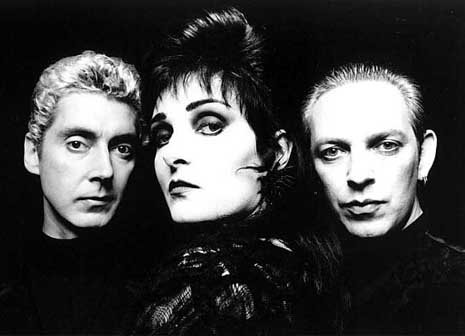| 77 |
Formed London, 1976; split 1996. "My
earliest memory is pretending to be dead. Through all her mutations of image - from Sex-Pistols-fan-cum-go-go-dancer, via 80s icon to relaxed 90s rock veteran - Siouxsie Sioux has defined The Banshees. Members have come and gone - transients Adam Ant and the Cure's Robert Smith among them - but she has always been the pivot of the band. Born Susan Dallion in 1957, Siouxsie was one of a gang of suburban bored teenagers known as the Bromley Contingent, a crew who embodied the decadent end of early British punk, and had a fondness for Nazi regalia. A proto-Banshees (featuring Sid Vicious on drums), debuted at the almost-mythical 'Punk festival' held at London's 100 Club in 1976 with a twenty-minute bludgeoning of the Lord's Prayer that ensured them a place in punk lore. A few weeks later, Siouxsie was part of the group of fans that helped destroy Bill Grundy's TV career when the Pistols came on to his show. Two years, dozens of gigs and a forest of press coverage later, The Banshees - Siouxsie Sioux (vocals), Steven Severin (bass), John McKay (guitar) and Kenny Morris (drums) - were at the cutting edge of the new wave, beloved of John Peel and scaring the pants off new arrivals on the scene. After the pop-punk effervescence of their first UK Top 10 hit, "Hong Kong Garden", their sound was captured perfectly on the splendid The Scream (1978), which chewed up bleak visions of urban collapse in brilliantly attitudinous, brooding music. The Banshees' total rewiring of The Beatles' "Helter Skelter" - which closed the album - was a classic piece of punk subversion. Acclaim and sales followed. A shame, then, that their follow-up, Join Hands (1979), should be a half-finished chart and critical failure, though it did include a rather fetching "Lord's Prayer", in the spirit of the glorious 100 Club version. The band then split acrimoniously mid-tour. Sioux and Steve Severin persevered, bringing in ex-Slits' drummer Budgie and guitarist John McGeogh. The atmospheric, synth-fuelled Kaleidoscope (1980) featured the skewed pop genius of "Happy House" (a UK Top 20 hit); the LP made the UK Top 5. As they moved gradually away from their hardcore punk roots, they began to build a wider audience and it was the vastly influential Juju (1981) that propelled them to the very front of the alternative rock scene. This brilliant album created more templates for 80s psychedelia, Goth and shoegazing than their more press-friendly copyists even knew existed. Siouxsie and Budgie embarked on a parallel project at this point, forming an on-off splinter group called The Creatures, while keeping The Banshees' momentum going. The Banshees' mesmerizing A Kiss In The Dreamhouse (1982) pushed forward experimentally, throwing tape loops, strings, recorders and dance rhythms into an intoxicating brew and, as the year closed, The Banshees' old claim to be 'the best band in the world' seemed more and more reasonable. Their claim to be the only major British band to play a benefit gig for the Italian Communist Party stands unchallenged. Typically, they threw it all away. October 1983 brought a UK Top 3 hit with another Beatles cover, "Dear Prudence", with Robert Smith handling guitar duties in the wake of McGeogh. But, with no new material, the rush-released live double LP Nocturne was an unconvincing cash-in. Still, in the eyes of their solid fan base, The Banshees could do little wrong. They'd changed into something approaching Goth and spent the mid-80s noodling around with moods and atmospheres in the studio, and still the faithful were happily trotting off to the record stores. It mattered little to them that Hyaena (1984) was written off as an overproduced and uninspired set by the music press, which had just fallen in love with guitar pop again. Nor that Tinderbox (1986), with John Carruthers replacing Smith, was seen as slightly better, if flawed. And after that, a cover version of Dylan's "This Wheel's On Fire" - which owed far more to Julie Driscoll's version than it did to Bob's - took the band back into the UK singles chart and prompted an entire LP of covers, Through The Looking Glass (1987), which brought the band into even wider public view. Following a long break, the band recruited the cellist/keyboardist Martin McCarrick and guitarist Jon Klein (replacing Carruthers) stormed back again with one of their best singles and LPs. "Peek-A-Bo" soared up the UK and US charts carried on house rhythms and waltzing accordions, and the masterful, menacing Peepshow (1988) took them once more into unfamiliar stylistic terrain. Superstition (1991) followed and proved their most accessible set, distinguished by perfect dance-pop like "Kiss Them For Me", which broke the US Top 30. Another long break preceded the elegant and critically acclaimed The Rapture (1995) which again stands among The Banshees' finest work, adding another remarkable stage in their remarkable career. Siouxsie and Budgie (who married in 1991) split the band in 1996, partly as a response to the Sex Pistols reunion. Hopefully her future career, working with The Creatures, will be successful enough to avoid having to play the punk revival game herself. In the photo gallery you'll find Check out these tasteful
Siouxsie and the Banshees homepages: |
77 |
